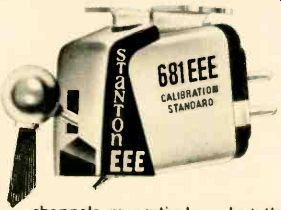
Stanton Makes Its Best Better
The Equipment:
Stanton 681EEE, a stereo phono cartridge with elliptical stylus. Price: $82. Warranty: guaranteed against defects in materials and/or workmanship.
Manufacturer: Stanton Magnetics, Inc., Terminal Drive, Plain view, N.Y. 11803.
Comment: There can be no doubt that the latest 681, the "Triple E," is the best stereo pickup offered by Stanton and certainly one of the very best we have ever tested. It is the most recent model in Stanton's "calibration standard" series, which for some time has designated the company's top-of-the-line stereo pickups. Each one is tested individually by Stanton, and the performance data is en closed with the unit. The deluxe packaging includes a screwdriver that is uniquely stylish, plus a small pillbox for holding extra styli (the 681 body accepts conical and 78-rpm styli, also made by Stanton) and mounting hardware.
The cartridge comes with Stanton's "long hair" brush that sweeps the record groove ahead of the stylus. The stylus itself is a true elliptical with, in the words of CBS Labs, "excellent geometry" and measures 0.8 by 0.3 mils.
The manufacturer recommends a vertical tracking force range of 3/4 to 1 1/2 grams. In the SME arm (used in all CBS Labs pickup tests), the 681EEE was found to perform optimally near the middle of that range, at 1 gram, although it needed only 0.6 gram to negotiate the "torture test" bands of test records STR-120 and STR-100. Measurements were made using the 47,000-ohm load and 275-picofarad cable capacitance specified by Stanton. The results show unusually linear frequency response across the audio band, very close channel balance, and stereo separation consistently averaging better than 25 dB to beyond 10 kHz.
Output voltage (for a recorded velocity of 5 cm/sec peak) measures 3.3 and 3.2 millivolts on left and right charnels, respectively--values that are well balanced and well suited for typical magnetic phono inputs on today's high quality amplifiers or receivers. Vertical angle measures 18 degrees, and low-frequency resonance in the SME arm is adequately low at 7 Hz. Distortion measurements--both harmonic and IM--are lower than average. In maximum tracking level tests, the 681EEE handles signals of up to +12 dB (RIAA) at 300 Hz and at 1 kHz, and better than-5 dB in the 10-to-20-kHz region, with no signs of mistracking in this difficult high-frequency area.
In direct comparison with its predecessor, the 681EE, the Triple E exhibits definite improvement over an already very good pickup. In the newer model, response is smoother and separation more consistent, while such characteristics as distortion and groove-tracing ability are at least as good.

-----------Square-wave response
As may be expected, the cartridge "listens" as beautifully as it measures. The manufacturer states that it is designed for "critical listening," and we agree. It strikes us as a truly neutral pickup that can elicit the full range of sound engraved on a disc, and without faltering at the mos-. demanding of groove modulations. It is the kind of pickup a sound enthusiast will want to try on such sonic blockbusters as the Solti /Chicago Symphony Orchestra recording of Stravinsky's The Rite of Spring (London CS 6885) or, for a different kind of sonic satisfaction with equal felicity, the demanding piano work in Beethoven sonatas recorded by Claudio Arrau (Philips 6599 308).

--Left channel, +1/2,-2 1/2 dB. 20 Hz to 20 kHz
--Right charnel: +1/4,-2 1/2 dB. 20 Hz to 20 kHz

-------------
(High Fidelity, Jul. 1975)
Also see:
Stanton Model 881S phono cartridge (Equip. Report, Nov. 1977)